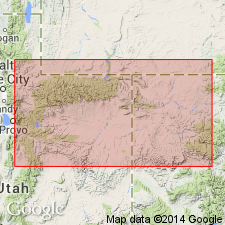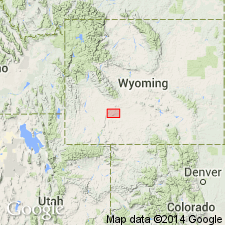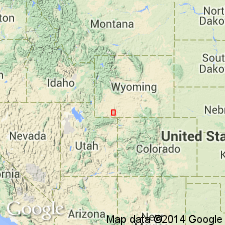
- Usage in publication:
-
- Tower sandstone*
- Modifications:
-
- Original reference
- Dominant lithology:
-
- Sandstone
- AAPG geologic province:
-
- Green River basin
Summary:
Pg. 40, 46. Tower sandstone. Massive or irregularly bedded ferruginous sandstone. Is lower part of Upper Green River group, and well shown in cliffs at Green River Station and in that vicinity, especially up and down the river for several miles; is also well exposed on east side of Green River below mouth of Currant Creek. Rests unconformably on Lower Green River group and is overlain by the plant beds that form upper part of Upper Green River group.
Source: US geologic names lexicon (USGS Bull. 896, p. 2173).

- Usage in publication:
-
- Tower sandstone lentil*
- Modifications:
-
- Revised
- AAPG geologic province:
-
- Green River basin
Summary:
Changed in stratigraphic rank from Tower sandstone to Tower sandstone lentil of Green River formation. Overlies Laney shale member of Green River. Was named for features called "The Towers" near the Green River. Underlies Morrow Creek member (new) of Green River. May be replaced in northern Sweetwater Co, WY in Greater Green River basin, by plant-bearing beds of lower part of Morrow Creek. Cross section. Inferred to be of Eocene age.
Source: GNU records (USGS DDS-6; Denver GNULEX).

- Usage in publication:
-
- Tower sandstone lentil*
- Modifications:
-
- Revised
- AAPG geologic province:
-
- Green River basin
Summary:
Tower sandstone assigned to the lower part of the Laney Shale Member of Green River formation in southwest WY in the Greater Green River basin. Base of Tower does not coincide with base of Laney at most places. Tower is a uniformly fine grained crystal tuff and not a fluviatile deposit of clastic coarse-grained sand grains as previously thought. Of Eocene age.
Source: GNU records (USGS DDS-6; Denver GNULEX).

- Usage in publication:
-
- Tower Sandstone Lentil†
- Modifications:
-
- Abandoned
Summary:
Name Tower Sandstone Lentil of Green River Formation has been applied to resistant lenticular sandstone and siltstone bodies that occur at many different horizons, mostly lower 400 ft, in the Laney Shale Member of the Green River Formation of Eocene age, Sweetwater Co, WY in Greater Green River basin. Name Tower therefore abandoned.
Source: GNU records (USGS DDS-6; Denver GNULEX).
For more information, please contact Nancy Stamm, Geologic Names Committee Secretary.
Asterisk (*) indicates published by U.S. Geological Survey authors.
"No current usage" (†) implies that a name has been abandoned or has fallen into disuse. Former usage and, if known, replacement name given in parentheses ( ).
Slash (/) indicates name conflicts with nomenclatural guidelines (CSN, 1933; ACSN, 1961, 1970; NACSN, 1983, 2005, 2021). May be explained within brackets ([ ]).

